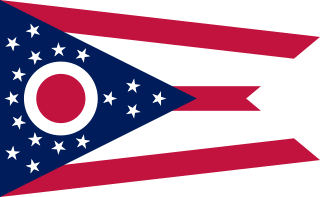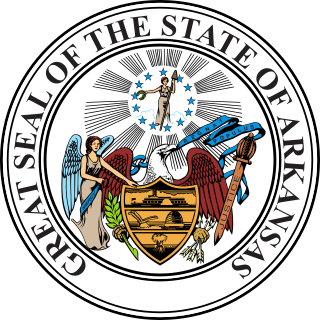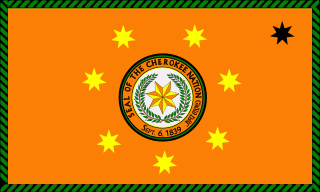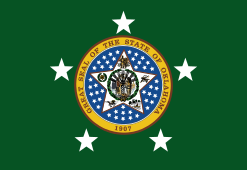
The flag of Oregon is a two-sided flag in navy blue and gold with an optional gold fringe. On the front is the escutcheon from the state seal and on the reverse is a gold figure of a beaver, the state animal. Oregon is the only U.S. State to feature different designs on both sides of its flag.

A pentagram is a regular five-pointed star polygon, formed from the diagonal line segments of a convex regular pentagon. Drawing a circle around the five points creates a similar symbol referred to as the pentacle, which is used widely by Wiccans and in paganism, or as a sign of life and connections.

The Ohio Burgee is the official flag of the U.S. state of Ohio. It is a distinctive triangular swallowtail flag. Its red, white, and blue elements symbolize the state's natural features and order of admission into the Union. A prominent disc in the flag's triangular canton is suggestive of the state's name. The flag was adopted in 1902.

The state flag of Arkansas, also known as the Arkansas flag, is a red banner charged with a large blue-bordered white lozenge (diamond). Twenty-nine five-pointed stars appear on the flag: twenty-five small white stars within the blue border, and four larger blue stars in the white diamond. The inscription "ARKANSAS" appears in blue within the white lozenge, with one star above and three stars below. The star above and the two outer stars below point upwards; the inner star below points downwards. The flag was designed by Willie K. Hocker of Wabbaseka, a member of the Pine Bluff Chapter of the Arkansas Society of the Daughters of the American Revolution.

The state flag of the U.S. state of Minnesota consists of a dark blue field representing the night sky and the state's shape, an eight-pointed star representing the North Star, and a bright blue field representing the state's abundant waters; the star is based on one prominently featured in the Minnesota State Capitol rotunda.

The flag of the Rhode Island is white and consists of a gold anchor in the center surrounded by thirteen gold stars. A blue ribbon below the anchor bears the state's motto in gold: "HOPE". The flag is frequently depicted with golden fringe around the edges of the flag, although the fringe is never actually on the flag unless it is used in federal-level displays, much like the national flag.

The state flag of Vermont displays the state's coat of arms and motto on a rectangular blue background. The Vermont General Assembly adopted the flag on June 1, 1923.

The U.S. state of New Hampshire has held two seals since it declared its independence from Great Britain on January 5, 1776. While both seals have been retained, most people are only familiar with the Great Seal due to its corporate use.

The Great Seal of Oklahoma was officially adopted in 1907 and is used to authenticate certain documents issued by the Government of Oklahoma. The phrase is used both for the physical seal itself, which is kept by the Secretary of State, and more generally for the design impressed upon it.

The Seal of the State of Texas was adopted through the 1845 Texas Constitution, and was based on the seal of the Republic of Texas, which dates from January 25, 1839.

The Great Seal of the State of Illinois is the official emblem of the U.S. state of Illinois, and signifies the official nature of a document produced by the state. The present seal was designed and proposed in 1868 and officially adopted in 1869. It depicts in profile a bald eagle perched on a rock with wings spread and holding a shield, with a banner in its beak and sunrise over water in the background. It replaced an earlier seal that was almost the same as the Great Seal of the United States, adopted when Illinois became a state in 1818.

The Great Seal of Arkansas is used to authenticate certain documents issued by the Government of Arkansas. The phrase is used both for the physical seal itself, which is kept by the governor, and more generally for the design impressed upon it. The seal was modified to its present form on May 23, 1907.

The seal of the Territory of Idaho was adopted in 1863 and redrawn several times before statehood in 1890. The first state Great Seal was designed in the 1890s by Emma Edwards Green, the only woman to design a U.S. state seal. That seal was used until 1957, when the seal was slightly redrawn by Paul B. Evans and the Caxton Printers, Ltd. at the request of the state government, in order to add more anthropocentric elements to the centered shield.

The flag of the Cherokee Nation was adopted by the Cherokee Nation of Oklahoma on October 9, 1978.

The flags of New York City include the flag of New York City, the respective flags of the boroughs of The Bronx, Brooklyn, Manhattan, Queens, and Staten Island, and flags of certain city departments. The city flag is a vertical tricolor in blue, white, and orange and charged in the center bar with the seal of New York City in blue. The tricolor design is derived from the flag of the Dutch Monarchy—the Prince's Flag—as used in New Amsterdam in 1625, when that city became the capital of New Netherland.

A five-pointed star (☆), geometrically an equilateral concave decagon, is a common ideogram in modern culture. Comparatively rare in classical heraldry, it was notably introduced for the flag of the United States in the Flag Act of 1777 and since has become widely used in flags.

New England has no official flag. However, there have been many historical or modern banners used to represent the region in its history. While there are some variations, common designs include a plain colored field with a pine tree in the canton. The eastern white pine is the most common and prominent symbol of New England and is featured on many of the region's flags.

Since unification in 1910, South Africa has used a range of national symbols to identify the country: coats of arms, official seals, flags, national anthems, and floral, bird, animal, and other emblems.

The seal and flag were the symbols of the Panama Canal Zone, an unincorporated territory of the United States, that existed from 1903 to 1979. The seal was adopted in 1906, and the flag in 1915. They were used until October 1, 1979, when the territory ceased to exist.




















